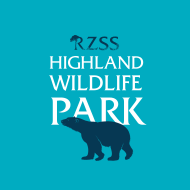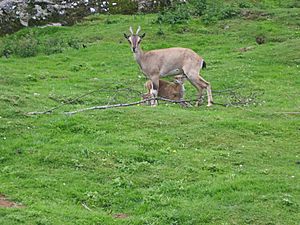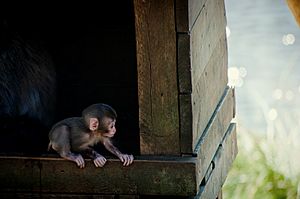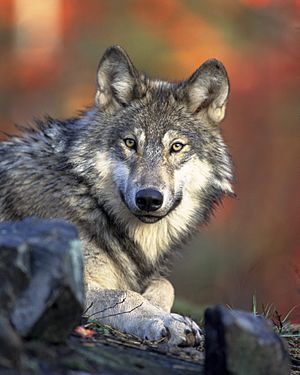Highland Wildlife Park facts for kids
 |
|
| Date opened | 1972 |
|---|---|
| Location | Kingussie, Scotland |
| Land area | 105 hectares (260 acres) |
| Coordinates | 57°6′40″N 3°58′29″W / 57.11111°N 3.97472°W |
| No. of animals | 300+ |
| No. of species | ~60 |
| Annual visitors | 142,000 (2019) |
| Memberships | BIAZA, EAZA |
| Major exhibits | Native Scottish wildlife |
The Highland Wildlife Park is a huge safari park and zoo in Kingussie, Scotland. It covers about 105 hectares (that's like 260 football fields!). The park is nestled inside the beautiful Cairngorms National Park.
It's run by the Royal Zoological Society of Scotland, which also looks after Edinburgh Zoo. The park is a member of important groups like BIAZA and EAZA. These groups help zoos work together to protect animals.
Contents
Discovering the Park's Past: A Journey Through Time
The Highland Wildlife Park first opened its gates in 1972. Since 1986, the Royal Zoological Society of Scotland has been in charge. The park is open almost every day of the year, no matter the weather, except for Christmas Day.
In 1980, a special animal made the park famous. This was "Felicity the Puma." She was a puma that a farmer supposedly found nearby. Felicity lived out her days happily at the park. Today, you can see her preserved at the Inverness Museum. The park has also been home to the mysterious "Kellas cat" in the past.
In 2007, the park's focus changed a bit. It used to show mostly animals from the Scottish Highlands. Now, it also features animals from cold, mountainous places around the world. This change helps the park work more closely with Edinburgh Zoo. It also helps protect more types of animals.
The park's new animals are often very endangered. Their presence at the park helps keep them safe. It also shows how the Scottish Highlands connect to the wider world of nature.
Some people missed seeing only Scottish animals. But the park explains that these new animals help save species globally. They also show how important the Highlands are in the world's natural system.
New Arrivals: Welcoming Global Wildlife
The first new animals arrived in February 2007. These were two bharals, a type of wild sheep. Soon after, markhor and yak joined the park family. Kiang and Japanese macaques also arrived that year.
In 2008, even more amazing animals came to the park. These included Bactrian wapiti, Chinese grey goral, Mishmi takin, and red pandas. Himalayan tahr, Carpathian lynx, Afghan urial, and European elk also found new homes here. Some of these animals came from Edinburgh Zoo.
A special aviary was built in 2008 for Himalayan snowcock. The park also celebrated many new births. These included Mishmi takin, kiang, markhor, and urial babies.
Exciting New Enclosures and Births
A brand new enclosure for Amur tigers opened. It cost £400,000 to build. This enclosure is home to Sasha and Yuri, a breeding pair from Edinburgh Zoo. In May, three tiger cubs were born! They are now exploring their new home with their mum, Sasha. Other births in 2009 included the first European elk and Himalayan tahr born at the park.
In 2011, a new home for European wolves opened. There was also a new enclosure for Pallas cats. A group of male vicuna arrived from Edinburgh Zoo. European cranes also joined the park. The Pallas cats had three adorable kittens!
New aviaries were built for snowy and great grey owls. Two female musk ox arrived from the Netherlands. They were the first musk ox imported into the UK in over 20 years.
Five female white-lipped deer came from Edinburgh Zoo. They are the only females of their kind in the UK. A new enclosure for European forest reindeer was built next to the European wolves.
A new male polar bear and a male Amur tiger arrived in 2012. Five European wolves, a Japanese serow, and two northern lynx were born. A male musk ox came from Sweden, and two red pandas joined the collection.
A new home for Chinese grey goral was built. Their old home was then prepared for wolverines. Wolverines arrived, and many babies were born in June 2013. These included the park's first great grey owl, white-lipped deer, red panda, and musk oxen. There were also babies from Turkmenian markhor, European lynx, Amur tiger, Bactrian wapiti, and Mishmi takin.
In 2014, a female European bison was sent to Romania to help reintroduce the species there. The park also celebrated many births. These included six Pallas cat kittens, two female Mishmi takin, and the first satyr tragopan hatching.
Construction began in summer 2014 for a new polar bear enclosure. A female polar bear was expected to arrive in spring 2015. It was also confirmed that snow leopards and Amur leopards would arrive in 2015. The last bharal and Japanese serow left the park in 2014.
In 2015, a female polar bear arrived from Aalborg Zoo in Denmark. She moved into a special enclosure. A male polar bear was later introduced to her. In 2018, a polar bear cub was born at the park!
The park's first snow leopards arrived from other zoos. They were released into a cliff-face enclosure next to the markhor. April 2016 saw the first birth of twin wolverine kits at the park and in Scotland.
In 2016, the last of the eastern kiang herd moved to another safari park. A male European forest reindeer was born in June. The park also welcomed its first Amur leopard. This leopard is housed in a special breeding area. This pair of Amur leopards had twins in summer 2018.
The first polar bear born in the UK in 25 years arrived at the end of 2017. The female polar bear Victoria gave birth to a male cub named Hamish just before Christmas. The park also celebrated the first European crane and snow leopard births in 2019.
Exploring the Park: What You Can See
Visitors to the Highland Wildlife Park can experience Scottish wildlife. You can see animals that live in Scotland today. You can also see animals that lived here thousands of years ago. Plus, there are animals from mountainous regions all over the world. You can drive your car around the Main Reserve. Then, you can walk around other areas to see more animals.
Meet the Animals: Park Residents
Main Reserve (Safari Park)

- European elk
- European bison
- Przewalski's horse
- Red deer
- Bactrian camel
- Bactrian wapiti
- Vicuna
- Yak
- Himalayan tahr (the only herd in the UK)
- Mishmi takin
Walk-round enclosures

- White lipped deer
- Scottish wildcat
- Eurasian Eagle owl
- Capercaillie
- Northern lynx
- Common crane
- European wolf
- Satyr tragopan
- Temminck's tragopan
- Polar bear
- Chinese grey goral
- Turkmenian markhor
- Red panda
- Snowy owl
- Great grey owl
- Arctic fox
- Japanese macaque
- Amur tiger
- Musk Ox
- European beaver
- Wolverine
- Snow leopard
- European forest reindeer
The Park's Future: What's Next?
The park is currently looking into exciting plans for the future. They are studying how to make the park even bigger. This would allow them to welcome even more amazing animal species.


